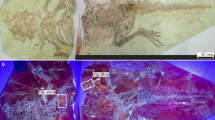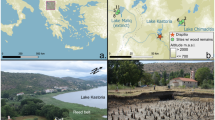Abstract
THE history of the Amphibia Salientia can readily be traced back to the Jurassic when it appears that, skeletally at least, they were already typical, modern Anura. The pre-Jurassic history of frogs, however, was completely unknown until 1937 when Piveteau1 described Protobatrachus massinoti from the lower Trias of Madagascar. To accommodate Protobatrachus, Piveteau denned a new order, the Proanura, differing from the Anura chiefly in possessing a tail but no urostyle and with the tibia and fibula, radius and ulna, unfused.
This is a preview of subscription content, access via your institution
Access options
Subscribe to this journal
Receive 51 print issues and online access
$199.00 per year
only $3.90 per issue
Buy this article
- Purchase on Springer Link
- Instant access to full article PDF
Prices may be subject to local taxes which are calculated during checkout
Similar content being viewed by others
References
Piveteau, J., Ann. Paleontol., 34, 135 (1937).
Author information
Authors and Affiliations
Rights and permissions
About this article
Cite this article
GRIFFITHS, I. Status of Protobatrachus massinoti . Nature 177, 342–343 (1956). https://doi.org/10.1038/177342b0
Issue Date:
DOI: https://doi.org/10.1038/177342b0
This article is cited by
-
The fossil record of lissamphibians from Africa, Madagascar, and the Arabian Plate
Palaeobiodiversity and Palaeoenvironments (2016)
-
Fossil Frogs from a Lower Cretaceous Bed in Southern Israel (Central Negev)
Nature (1956)
Comments
By submitting a comment you agree to abide by our Terms and Community Guidelines. If you find something abusive or that does not comply with our terms or guidelines please flag it as inappropriate.



